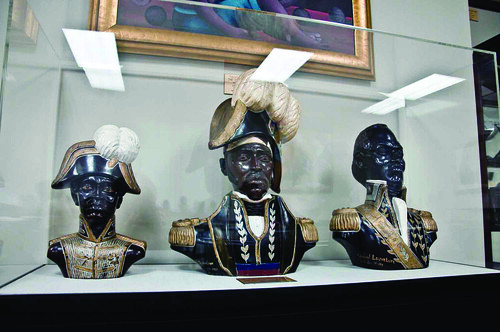Charles Blockson was the guest of honor at an event held at his collection on Main Campus last week, delivering powerful, informative speeches.

Temple student Britney Blackwell led the standing-room-only crowd with the Negro spiritual, “John Brown’s Body,” at the Main Campus’ Blockson Collection, located on the first floor of Sullivan Hall, on the 150th anniversary of the Caucasian abolitionist’s hanging.
A blend of press conference, history lesson and Baptist church ceremony, the normally quiet Blockson Collection was in for a surprise last Wednesday.
In attendance at the 2 p.m. event called “John Brown in the African Mind” was the collection’s namesake, Charles L. Blockson, who donated all the 500,000 artifacts, which date back to 1581 and include rare books, paintings and slave narratives. Blockson delivered a passionate speech on the controversial legacy of Brown, who led a violent attempt at freeing slaves in the late 1850s.
After a few kind words from the collection’s curator, Dr. Diane Turner, and Dean of University Libraries Larry P. Alford, followed by an opening prayer from Reverend Solomon Roebuck, Blockson was introduced.
Surrounded by large, lifelike statues, paintings and other artifacts in the collection, Blockson, an ex-track and -football star, who turned down a chance to play for the NFL’s New York Giants, said he considered Brown “a man of action.”
The two-hour event focused on Brown’s positive influence, such as how he led the longest trip on the Underground Railroad – traveling through Missouri, Iowa and Illinois to free slaves.
In May 1856, Brown – in his 50s and fed up with the treatment of enslaved Africans – led his first violent revolt. His efforts ended three years later when he was hanged in Charleston, N.C., with some of the 20 children he fathered, who helped with the revolts.
Blockson, a native of nearby Norristown, Pa., who wrote his first of 11 books in 1981, did not stop with his lecture on Brown.
Blockson went into great detail on the Underground Railroad. Blockson may be one of the foremost knowledgeable people on the subject: An autographed copy of National Geographic, to which Blockson contributed his familiarity with the Underground Railroad, can be seen on display at the Blockson Collection.
The collector, who is a relative of railroad leader Harriet Tubman, said his “emotional armor erupted” when he first visited her grave. He also said he just received some items belonging to Tubman, including a shawl.
But the mood was not glum, as Blockson joked that when he was younger, he envisioned the railroad being an actual “choo choo” train and then delivered a poem about the means by which blacks escaped slavery, including Blockson’s great grandparents, who escaped to Canada.
The spry Blockson, now in his 70s, also told stories of Nat Turner, who was born the same year as Brown and also led a brutal revolt resulting in his own death. The highly engaged crowd of many ages and races even included a small group that traveled from Swarthmore College to attend.
World-renowned Temple professor Molefi K. Asante was also scheduled to speak, however, he was out of the country on a trip to Africa. Asante sent one of his grad students to give a prepared speech about his thoughts on Brown’s historical relevance.
Jermar Perry can be reached at jkperry@temple.edu.



Apparently, you missed some of the story of john Brown.
He was hanged in Charles Town, Virginia, after being convicted of treason against the state of Virginia, inciting slave rebellion, and murder because of his capturing the army arsenal at Harpers Ferry, Virginia.
As far as I am aware, he was never in Charleston, N.C.
This year many Americans are commemorating the 150th anniversary of his martyrdom, because what he did led to the ending of the horror of the institution of slavery. That was the whole point of the evening you attended, but you seem to have missed it.
I wish I could have been there.
Fred Mecoy
Allen, Tx